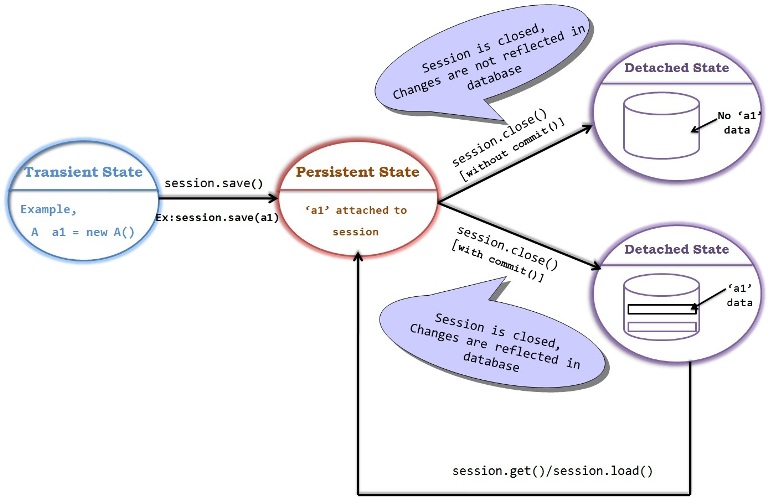Object Lifecycle and states in Hibernate
- 3rd Feb 2017
- 2
- 15349
- difference between transient different states of an object in hibernate How persistent object becomes detached object How transient object becomes persistent object object lifecycle in hibernate persistent and detached state in hibernate What are the different states of an object in hibernate what is detached state or object in hibernate what is persistent state or object in hibernate what is transient state or object in hibernate
Looking at the state of an object in Hibernate, we will get to know whether object is saved into Database or not.
The 3 states of an object in Hibernate
Transient
Persistent
Detached

Let’s see these states in detail with example
Transient state
A transient object is one that Hibernate has no idea on it.
It’s the first state of any object in the Hibernate Life cycle.
Any object which is not associated with hibernate session and does not represent a row in the database is considered as transient.
It will be garbage collected by JVM,If no other object is referencing it.
An object that is created using the new() operator is in transient state.
When the object is in transient state then it will not contain any identifier (primary key value).
We have to use session methods like save, persist or saveOrUpdate methods to persist the transient object.
Example:
- User user = new User();
- user.setName("kb");
User user = new User();
user.setName("kb");
Now user object is not associated with any session and hence it can be called as Transient object.
Persistent state
An object that is associated with the hibernate session is called as Persistent object.
When an object is in a persistent state, Hibernate is totally aware of it.
It also represents one row of the database and consists of an identifier value.
We can make a transient instance persistent by associating it with a Session like below
- Long id = (Long)session.save(user);
- //This object is in persistent state
Long id = (Long)session.save(user); //This object is in persistent state
Object can get the Persistent state in the below 2 scenarios
1) Load the object from the Database using Hibernate API
In this case, we load the existing object from the database and it will be automatically associated with the session.
2) Save the object into the database using Hibernate API
In this case new transient object created using “new” operator will be attached to the session and it becomes Persistent object.
Note: Object in Persistent state will be saved only when the Transaction is committed.
Detached state
The detached state is given to an object that was previously “attached” to the Session (persistent state) but has now left the association with the Session.
Example:
- Session.close();
- //All the objects will be in detached state after this line execution
Session.close(); //All the objects will be in detached state after this line execution
All the persistent objects within the Session will get the detached state when we close the session.
If we would have done transaction commit before closing the Session then all Persistent objects will be saved into Database otherwise those persistent objects will be lost.
So object in Detached State may present in the Database but not guaranteed.
So most important thing is to commit the transaction before closing the Session.
Look at the below diagram for better understanding on these states

Example to represent all the states together
- public class HibernateObjectStates {
- public static void main(String[] args)
- {
- User user= new User();
- user.setName("John");
- user.setCity("Newyork");
- //’user’ is in TRANSIENT state
- SessionFactory sessionFactory = new AnnotationConfiguration().configure().buildSessionFactory();
- Session session = sessionFactory.openSession();
- session.beginTransaction();
- session.save(user);
- //Here ‘user’ is in PERSISTENT state
- session.getTransaction().commit();
- //’user’ will be saved to Database
- session.close();
- //’user’ is in DETACHED object
- }
- }
public class HibernateObjectStates {
public static void main(String[] args)
{
User user= new User();
user.setName("John");
user.setCity("Newyork");
//’user’ is in TRANSIENT state
SessionFactory sessionFactory = new AnnotationConfiguration().configure().buildSessionFactory();
Session session = sessionFactory.openSession();
session.beginTransaction();
session.save(user);
//Here ‘user’ is in PERSISTENT state
session.getTransaction().commit();
//’user’ will be saved to Database
session.close();
//’user’ is in DETACHED object
}
}
Transient VS Detached state
Few people get confused with Transient and Detached State as both of them are not associated with the Session.
I believe below explanation will clear that confusion
Transient objects do not have any association with either database or session objects.
They are just created using “new”.
Once the reference is lost, object is collected by garbage collector.
The commits and rollbacks operation will have no effects on these objects.
They can become persistent objects through the save() method of Session object.
Hibernate does not even know that there is an object if it’s in Transient state
Detached objects will have corresponding entries in the database but they are not associated with the Session.
Detached objects were associated with Session and known to hibernate in the past but not currently.
The detached object can be reattached to session to make it persistent again.
Note:
If object is in transient state, then it is guaranteed that it has no existence in the database.
If object is in detached state, even though it is not guaranteed (depends on transaction is committed or not) but there is a possibility that object may have existence in the database already.

Very clear and nice explanation for beginners
awesome!